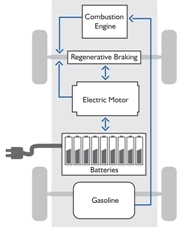Plug-In Hybrid Electric Vehicles Tutorial
See Also: The Alternative Fuels Data Center
As with other hybrids, a plug-in hybrid vehicle has the ability to run on either electricity or an internal combustion engine. Plug-in hybrids have a larger battery than the batteries of conventional hybrids that can be recharged by plugging into an appropriate outlet.
Recharged vehicles can provide 20-60 miles of all electric, zero emission range without engine power. Plug-in hybrids are being tested in prototype form and may soon be available for sale.
Advantages of Plug-in Hybrids:
-Reduced fuel consumption and tailpipe emissions
-Cleaner electric energy through advances in natural gas and coal gasification
-Optimized fuel efficiency and performance
-Recovered energy from regenerative braking
-Unchanged gas station infrastructure
-Grid connection potential
-"Home based" battery recharging at a fraction of the cost of petroleum equivalent
-Pure zero emission capability
-Even lower fueling costs compared to battery sustaining hybrids
-Possible use in secondary markets for used batteries and reduced waste
Challenges:
-Cost and complexity of two powertrains
-Component availability--batteries, powertrains, power electronics
-Higher initial cost
-Cost of batteries and battery replacement
-Added weight
Hybrid Electric and Fuel Cell Vehicles Plug-In Hybrid Electric Vehicles tutorial from National Renewable Energy Laboratory Advanced Vehicles and Fuels
Driving our gas or diesel powered vehicles today we spend about 12 cents per mile for this fuel. But if we were driving electric vehicle's we would only spend about 3 cents per mile. Electric vehicle operation is also clean, quiet, largely independent of imported petroleum, and highly amenable to using wind or other renewable energy generation.
A roadblock to success for electric vehicles has been their limited range. With hybrid-electric technology, however, that roadblock can now readily be overcome. Add extra batteries to a hybrid electric vehicle (HEV) and a way to "plug them in" and you can drive most of a typical day's mileage on clean, less expensive electricity, but still have an easily refillable fuel tank for longer trips. Some HEVs have already been converted to plug-ins and Mercedes-Benz is now making limited numbers of a demonstration plug-in Sprinter van.
Probably the biggest challenge plug-in hybrids have is the cost and weight of batteries. NREL is extensively researching thermal management, modeling, and systems solutions for energy storage technology. Even at today's battery costs, however, plug-ins may be able to repay their costs within a few years. NREL scientists and engineers also research improved power electronics critical to hybrid efficiency and conduct sophisticated modeling and analysis essential to showing the economic viability of plug-ins and identifying key areas for improvement.
NREL researchers are also seeking to carry the plug-in hybrid concept a couple steps farther by making the plug-in reversible. Called a "vehicle-to-grid" or "V2G", such a two-way plug allows the home and vehicle owner and local utility to take advantage of the extra electrical storage capacity in the vehicle batteries to meet peak demand, provide grid support services or respond to power outages. In addition, utilities pay premium rates for peak and backup power and might pay commuters to plug their vehicles in while at work to ensure their employer has high quality power throughout the day. NREL transportation analysts are quantifying the potential value of such systems.
Another next step is for a plug-in based renewable community. Drive home and plug your car into a house that requires little or no electricity and gets most of what it does need from renewable sources. Such "zero-energy homes" are readily available today-wouldn't whole communities of them together with plug-in hybrids be the perfect model for the future? NREL researchers are promoting the renewable community concept and doing the analysis and research needed to show their feasibility and outline their optimal design.



